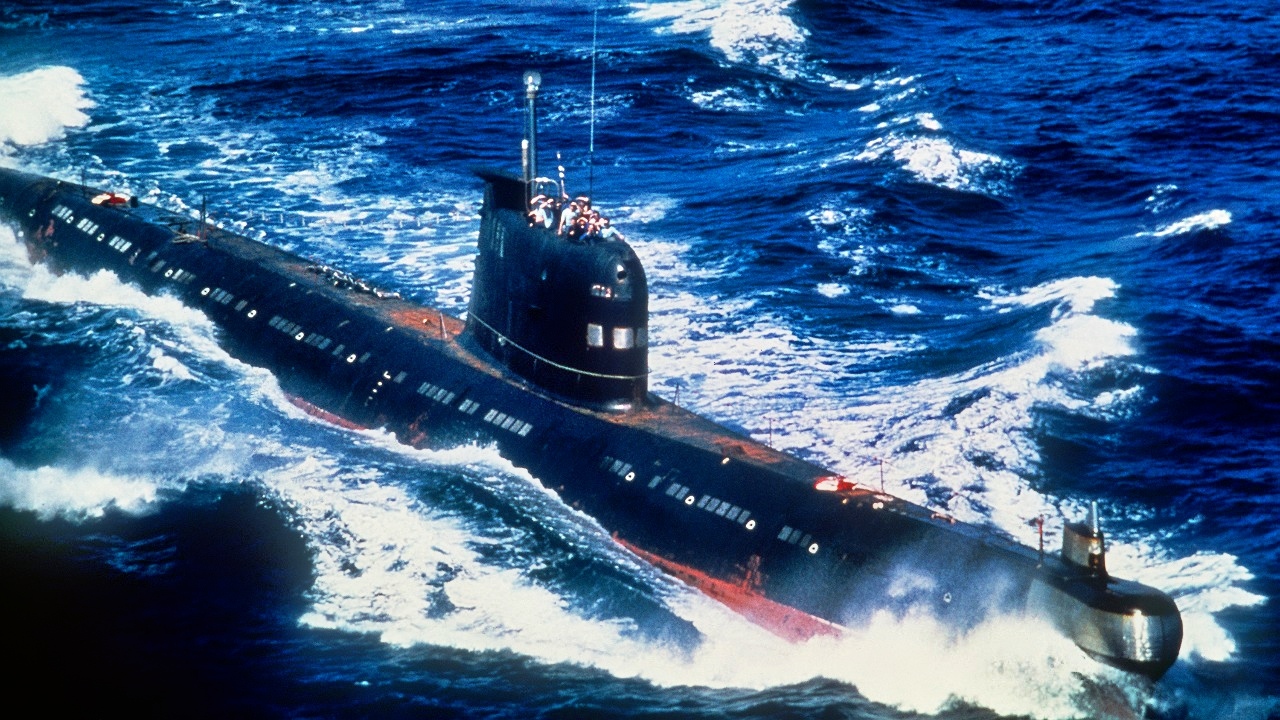Key Points – The Soviet Foxtrot-class (Project 641) was one of the most successful and prolific diesel-electric attack submarine designs of the Cold War, with 74 boats built between 1957 and 1983.
-Serving with the Soviet Union and numerous export customers like India and Poland, these submarines were valued for their impressive 20,000-nautical-mile range and heavy torpedo armament (10 tubes, 22 reloads).
-They played a critical strategic role during events like the Cuban Missile Crisis.
-However, the Foxtrot-class was also known for its significant drawbacks, including being notoriously noisy due to its three-screw propulsion design, which ultimately limited its stealth capabilities.
The Soviet Foxtrot-Class: An Enduring Cold War Diesel-Electric Submarine
The Soviet Navy’s Foxtrot-class submarine stands as one of the most successful diesel-electric attack boat designs of the post-World War II era.
Its longevity and widespread service are testaments to a uniquely Soviet approach to weapons development, characterized by continuous, iterative improvement over decades of production.
A Hallmark of Soviet Design: Evolutionary Development
The design of the Foxtrot-class was far from static. Instead, it was subjected to an ongoing design-production-redesign cycle that spanned from 1957 to 1983. This evolutionary method of perfecting a weapon system by producing one modernized version after another was a defining feature of the Soviet design philosophy.
In service from 1958, the Foxtrot-class remained a fixture of the Soviet and later Russian Navy, even as the final boats produced were considered obsolete by the time they were commissioned.
The last Russian Foxtrots were not retired from service until the mid-to-late 1990s. Exported versions remained in operation with foreign navies until as late as 2014.
A Prolific and Widely Exported Submarine
In total, seventy-four Foxtrot-class submarines were built. They served not only with the Soviet and Russian navies but also with the naval forces of Cuba, Libya, India, Poland, and Ukraine.
In a notable postscript to its service history, a single Ukrainian Foxtrot boat was seized by Russian forces during Moscow’s 2014 annexation of Crimea.
The Foxtrot was developed to replace the preceding Zulu-class, which had been found lacking in the power and speed required for its intended missions.
This led to the commissioning of a new design, which became the Foxtrot.
Construction and Technical Specifications
The new design was designated Project 641 (later receiving the NATO codename Foxtrot).
Sixty-two of these boats were built specifically for the Soviet submarine force in two production runs.
All were constructed at the Sudomekh Shipyard No. 196 in Leningrad (now St. Petersburg), a facility that later merged with the Admiralty Shipyards in 1970.
Key specifications of the Foxtrot-class include:
-Displacement: 2,000 tons (surfaced), 2,515 tons (submerged)
-Dimensions: 295 feet length, 24.2 feet beam, 19.3 feet draught
-Propulsion: A configuration of three Kolomna 2D42M diesel engines (2,000 hp each) and three electric motors of varying output (two at 1,350 hp, one at 2,700 hp).
Performance, Armament, and Operational Drawbacks
The Foxtrot could achieve surface speeds of 16 knots and submerged speeds up to 15 knots. Its impressive range of 20,000 nautical miles was well above average for a diesel-powered submarine of its era. A crew of 78 could remain submerged for up to five days. Its armament consisted of ten torpedo tubes (six bow, four stern) with a standard loadout of twenty-two torpedo reloads.
Assigned across all four Soviet Navy fleets, the Foxtrot-class was a crucial asset during the Cold War. The boats were considered fast and powerful for their time, but they had significant drawbacks. They were larger than many contemporary designs and boasted substantial underwater endurance thanks to extensive battery decks. However, this same feature contributed to their primary weaknesses: the three-screw propulsion design made them notoriously noisy, and the weight of the batteries limited their submerged speed.
A Strategic Role in the Cuban Missile Crisis
Despite these limitations, Foxtrot-class submarines played a critical role during the Cuban Missile Crisis. Four boats were deployed to the region, and three were ultimately forced to surface by U.S. Navy anti-submarine warfare ships.
Their presence during one of the most tense standoffs of the Cold War underscores their strategic importance. The Foxtrots demonstrated the USSR’s commitment to maintaining an effective underwater attack force at a time when few navies could match such a capability, a landscape that would later be transformed by the universal adoption of nuclear-powered submarines by major powers.
Export and Final Days of Foxtrot-Class
After their retirement from the Russian Navy, export customers continued to operate the Foxtrots. With the exception of the units sold to the Indian Navy, all export models were equipped with less capable electronics and weapon systems.
In their final years of Russian service, the remaining Foxtrots were utilized as Anti-Submarine Warfare (ASW) training platforms before being decommissioned. Several have since been preserved and are now displayed as museum ships.
About the Author:
Reuben F. Johnson is a survivor of the February 2022 Russian invasion of Ukraine and is an Expert on Foreign Military Affairs with the Fundacja im. Kazimierza Pułaskiego in Warsaw. He has been a consultant to the Pentagon, several NATO governments and the Australian government in the fields of defense technology and weapon systems design. Over the past 30 years he has resided in and reported from Russia, Ukraine, Poland, Brazil, the People’s Republic of China and Australia.
Hypersonic Weapons In Depth
Russia’s Hypersonic Missiles Summed Up in 4 Words











Pingback: Putin's Massacre: 996,150 'Dead and Wounded' for Russia in Ukraine War - National Security Journal